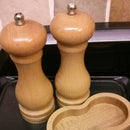Introduction: Giant Chess
Whilst an artist in residence at Instructables, I took up playing chess at lunch times against Dave. With chess on the brain, when I went home at night I noticed that the black and white tiled kitchen of the family I was staying with would be PERFECT for a game of giant chess.
Looking online to see what was already available, I found three problems:
1) Size: none of the sets advertised as giant, were actually very big
2) Ease of storage: all of the sets I found online were injection moulded plastic. I'd need a lot of space to store them!
3) Price: for a truly giant chess set I'd need to shell out $300+.
My solution was a simple laser cuttable giant chess set made from a light and strong plastic material called Coroplast, it's the stuff used for political and housing signs. The pieces would be comprised of two parts each that when slotted together would stand up and give a good representation of a chess piece, while being quick to disassemble and easy to store.
Anyone with access to a laser cutter with a bed size of 24" x 36" can use the included files to make their own copy of this giant chess set.
Step 1: Design & Prototyping
All of the pieces were designed in the free trial of my preferred CAD software, Alibre Design.
I first laser cut each piece from cardboard with a 6 inch base. Upon taking them back home to test them out I found I'd guessed the tile size in the kitchen wrong and so quickly scaled them up to a 9" base, giving me a king with a height of 27".
The 12 Alibre files are included in this step should you wish to modify them.
Attachments
Step 2: Tools & Materials
Tools:
Laser cutter
Sharp knife
Materials:
7 sheets 4mm black coroplast (24"x33")
7 sheets 4mm white coroplast
a little patience
The coroplast came to about $50.
Attachments
Step 3: Laser Cut
Using a 75W Epilog laser cutter I used the following settings:
Speed - 10
Power - 100
Frequency - 5000
I set the focus slightly below the top surface of the coroplast. I found with these settings it cut almost all the way through, leaving tabs where the ribs of the coroplast were. I chose these settings over a slower one which would cut all the way through to reduce melting and to get them cut quicker. A quick run round with a scalpel after cutting freed the pieces from the sheet.
Step 4: Assemble
With these chess pieces, setup is fast and easy. Choose two opposing pieces and slot them together. Due to their construction they can be taken apart as easily after each game and stored flat for convenience.
Step 5: Play!
Once your set's assembled, lay it out and have a game!
Toddlers will find this at first very interesting, then very boring.

Participated in the
EXTREME! Challenge

Participated in the
Make It Real Challenge














